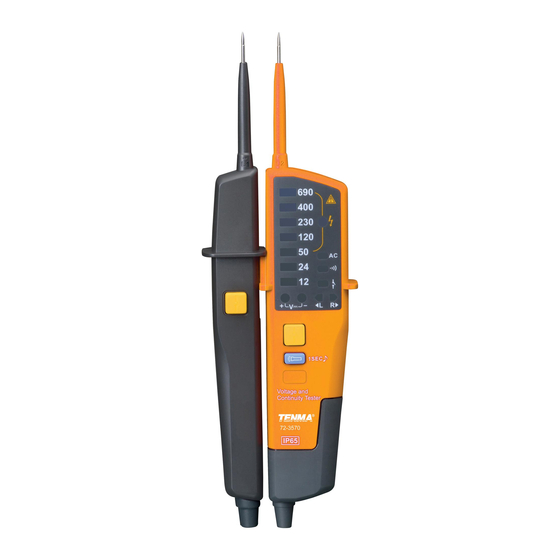
Table of Contents
Advertisement
Advertisement
Table of Contents

Subscribe to Our Youtube Channel
Summary of Contents for Tenma 72-3575
- Page 1 Voltage & Continuity Tester Models: 72-3570, 72-3575 & 72-3580...
-
Page 2: Table Of Contents
CONTENTS Page Number Details Important Safety Information Features Product Overview Voltage Measurement Single Test Pen Testing Detection Without Batteries (72-3570/72-3575) Continuity Test Rotation Test RCD Test Silent Mode Selection Torch Function Backlight Function (72-3580) Replacing the Batteries Technical Specification Special Functions LCD Display &... -
Page 3: Important Safety Information
Never dispose of batteries in a fire, or attempt to recharge ordinary batteries. FEATURES • LED indication (72-3570 & 72-3575). • LCD voltage and frequency display (72-3575 & 72-3580). • AC/DC measured up to 690V. • Detects a live wire by single test pen measurement. -
Page 4: Product Overview
PRODUCT OVERVIEW 72-3570 72-3575 72-3580 72-3570 72-3575 72-3580 1. Test pen L1 7. Continuity indication 13. Hold mode/backlight 2. Test pen L2 8. Polar indication 14. Torch 3. Voltage indication (LED) 9. Rotary phase indication 15. Test pen cap 4. LCD 10. -
Page 5: Voltage Measurement
If the measured voltage continues to increase and exceeds the input protection voltage (750VAC/DC) of the tester, the 12V~690V LED will keep flashing (72-3570 & 72-3575) or the LCD will display “OL” (72-3575 & 72-3580), while the buzzer will sound. -
Page 6: Single Test Pen Testing
AC LED will illuminate and a low voltage reading will be displayed. • The LCD may display a reading (72-3575/72-3580), but the voltage value should not be considered as the actual measured value as it is simply indicating the conductor is electrified. -
Page 7: Rotation Test
230V AC system under normal voltage measurement mode and press the yellow RCD key on the two test pens. • The RCD system should trip and the LED indicating RCD (72-3570/72-3575) or the RCD symbol (72-3580) will illuminate if the circuit then generates AC current higher than 30mA. -
Page 8: Silent Mode Selection
• After holding the torch button the tester will beep and the LCD will display the “mute” symbol (72-3575/72-3580) when it is in silent mode. • In silent mode all functions are the same as those in normal mode with the exception of the silent buzzer. -
Page 9: Technical Specification
TECHNICAL SPECIFICATION Function Range 72-3570 72-3575 72-3580 5V ± 1V 5V ± 1V 8V ± 2V 8V ± 1V 8V ± 1V LED segment (AC/ 18V ± 2V 18V ± 2V 18V ± 2V 38V ± 4V 38V ± 4V 38V ±... -
Page 10: Special Functions
120V 230V/400V/690V 72-3575 ± (1.5% + 1) ± (1.5% + 2) ± (1.5% + 3) ± (1.5% + 4) ± (1.5% + 5) 72-3580 ± (1.5% + 1) ± (1.5% + 2) ± (1.5% + 3) ± (1.5% + 4) ±... - Page 11 ≤85% RH Over voltage protection class CAT III 690V, CAT IV 600V Pollution class Safety rules IP65 EN61010-1, EN61243-3:2010 Weight (inclusive of batteries) 272g (72-3570/72-3575), 295g (72-3580) Dimensions 272 x 85 x 31mm Batteries IEC LR03 (AAA) x 2 (not included)
- Page 12 INFORMATION ON WASTE DISPOSAL FOR CONSUMERS OF ELECTRICAL & ELECTRONIC EQUIPMENT. When this product has reached the end of its life it must be treated as Waste Electrical & Electronic Equipment (WEEE). Any WEEE marked products must not be mixed with general household waste, but kept separate for the treatment, recovery and recycling of the materials used.
















Need help?
Do you have a question about the 72-3575 and is the answer not in the manual?
Questions and answers